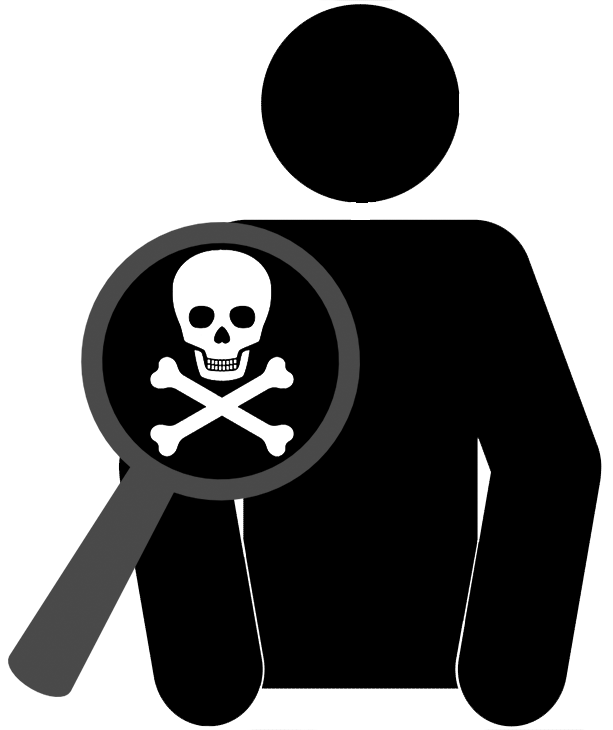Conceptual Model
The steps involved in being exposed to a contaminant of concern to a resulting adverse health outcome must be explored and established when conducting an exposure assessment. This involves identifying sources of exposure, how the contaminant behaves in the environment, and the context in which people come into contact with the contaminant that results in an adverse health effect. Below is a conceptual model for exposure-related disease that can be helpful in understanding the pathway from exposure to disease.
Sources/Emissions

The conceptual model suggests a pathway from exposure to the subsequent development of an adverse health outcome. Sources and emissions would be the starting point for the exposure of interest.
Sources of exposure are the places and/or events from where the contaminant of interest was initially released into the environment. Review the examples provide below. Try to identify at least three additional sources of exposure not mentioned.
- Agricultural practices
- Consumer products
- Industrial emissions
- Natural sources
- Vehicle emissions
- Waste collection and management
Environmental Media

Media are the environmental means through which individuals are exposed to an agent. Depending on the properties of a contaminants of concern and its original source, air, water and soil are the three media through which an agent can 'move' from its source.
- Air
- Biota (plants and animals)
- Soil/Sediment
- Water (e.g. ground water, surface water)
- Other parts of the environment that can contain contaminants
Microenvironments

Microenvironments are well-defined, relatively homogenous spaces with respect to concentration of a contaminant of concern. It may help to think of an individual's microenvironment as a map of an individual's immediate surroundings through which exposure may take place. Consider your microenvironments based on your daily activities and surroundings.
Examples of microenvironments:
- Home
- Workplace
- School/Daycare
- Transportation
- Parks and playgrounds
- Local facilities
Exposure Route
The routes of exposure are the pathways by which humans are exposed to agents, which generally takes place via dermal contact, inhalation, or ingestion. The exposure route is the final external event and explains how the agent moves from the external environment to the internal environment where impact on health takes place.
It's important to note that agents of concern may have different toxicities depending on the routes of exposure. Inhalation, ingestion, and dermal contact are typically the exposure routes for contaminants of concern.

Biomarkers

Biomarkers are biochemical, molecular, genetic, immunologic, or physiologic indicators of events in a biological system. They are markers of exposure, its given effect, and susceptibility. Review the following types of biomarkers.
- Absorbed Dose: Also known as the internal dose, absorbed dose is the amount of an agent that is available for interaction with biologically significant receptors within the human body.
- Biologically Effective Dose: The amount of a deposited or absorbed chemical that reaches the cells or target site where an adverse effect occurs.
- Altered Structure/Function: How biological systems or structures function and/or behave differently as a result of exposure to an agent.
Health Outcome

The final step along the exposure-disease pathway is the adverse outcome believed to be associated with exposure to a given agent. It's important to note that any given agent can be associated with a number of health outcomes depending on factors such as the dose, whether exposure was chronic or acute, and susceptibility.
It is important to identify a health outcome that is related to the nature of the exposure, specifically the duration, frequency and intensity of exposure. Health outcomes associated with acute exposures are often different from those associated with chronic exposure. Below are some examples of health outcomes based on acute and chronic exposure.
- Acute effects: Epithelial irritation, trauma due to injury (fall), respiratory distress, headache, blurry vision, hearing loss
- Chronic effects: cancer, cardiovascular disease, COPD, obesity, diabetes, chronic kidney disease, osteoporosis
Exposure Pathway
The exposure pathway is the physical course an environmental agent takes from its source to the receptor. To characterize the exposure pathway, one must consider the fate and transport of a given agent, meaning how will it behave in the environment or media and how or if it will come into contact with humans. If an agent is produced and emitted from a stack into the air, it will be available to the surrounding community in the ambient air, probably in the direction of the prevailing winds. If the agent is discharged into a river, then it will be available to the water and the biota in the river. The biota may be able to chemically change the agent so that when a person eats the biota, the agent may be more or less toxic than when it was originally discharged into the river.
Another factor that must be considered regarding a chemical's fate and transport is its potential for degradation in the environment and its half-life in specific environmental media. Some chemicals are broken down rapidly by sunlight, water, or bacteria into less toxic forms, while others may remain in the same form for a long time. Alternatively, some chemicals may form even more toxic by-products when they decay. The term used to describe a chemical that is resistant to degradation is "persistent." Persistent organic pollutants, such as. In addition, many chemicals bioaccumulate in the environment. For example, PCBs concentrate in fish and birds that eat fish.
Exposure Route
The routes of exposure are the pathways by which humans are exposed to agents. Agents of concern may have different toxicities depending on the routes of exposure. Inhalation, ingestion, and dermal contact are typically the exposure routes for environment contaminants.
For example, one might be exposed to intact lead paint on a windowsill by touching it. In this manner, the lead is not harmful. However, should the windowsill be sanded, you are now exposed to the lead by inhaling it, making it toxic as a function of the route of exposure.
Often times the agent of concern can be directly measured or modeled at the point of contact, for example, in the breathing zone, on the skin, or via dietary assessments.
Understanding the media in which an agent is found will allow you to understand the ways in which humans may be impacted. Some common media are:
- Water (drinking or recreational; groundwater or surface)
- Soils/sediments
- Air (indoor or ambient)
- Biota (plants, animals, microorganisms)

